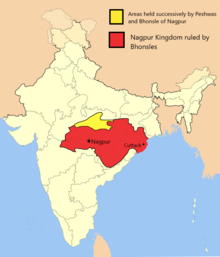Bhonsles of Nagpur
| Bhonsles of Nagpur | |
|---|---|
Kingdom of Nagpur |

The Bhonsles of Nagpur were a
Origin
The Bhonsle family branch of Raghoji were known as Hinganikar as they were originally chiefs of Berdi near Hingani in
Parsoji's son Santaji Bhonsle was part of various campaigns of Chhatrapati Shivaji and the other commanders, till his murder in Delhi during the 1719 campaign to depose Farrukhsiyar led by Senapati Khanderao Dabhade. Ranoji was given title of Sawai Santaji (meaning Superior Santaji) along with other compensations for the loss of his brother's life. In 1722, Chhatrapati Shahu Maharaj presented Badnera and Amravati to Ranoji further extending presence of Hinganikar Bhonsles in east. Kanhoji went on to secure the family title of Senasahibsubha after the death of Parsoji in 1709 or 1710. Senasahibsubha Kanhoji ruled for twenty years and laid the foundation of a strict rule in east Maharashtra.[4][5]
Ascension to power
After Chand Sultan, the Gond raja of Nagpur's death in 1739,[6] there were quarrels over the succession, leading to the throne being usurped by Wali Shah,[7][8][9] an illegitimate son of Bakht Buland Shah.[7][10] Chand Sultan's widow invoked the aid of the Maratha leader Raghuji Bhonsle of Berar in the interest of her sons Akbar Shah and Burhan Shah. Wali Shah was put to death and the rightful heirs placed on the throne. Raghoji I Bhonsle was sent back to Berar with a plentiful bounty for his aid. The Maratha general judged that Nagpur must be a plentiful and rich country by the magnificence of his reward.[9][11][12][13][14][15][16][7][17][6][8][10][18]
However, dissensions continued between the brothers and once again, the elder brother Burhan Shah requested the aid of Raghuji Bhonsla. Akbar Shah was driven into exile and finally poisoned at
History
The Bhonsles of Nagpur were near relations of
Deposition
Rulers
- Raghoji I Bhonsle(1739 – 14 Feb 1755)
- Janoji Bhonsle (1755 – 21 May 1772)
- Mudhoji Bhonsle(1772 – 19 May 1788)
- Raghoji II Bhonsle(1788 – 22 Mar 1816)
- Parsoji Bhonsle (1816 – 2 Feb 1817) (b. 1778 – d. 1817)
- Mudhoji II Bhonsle"Appa Sahib" (1817 – 15 Mar 1818) (b. 1796 – d. 1840)
- Raghuji Bhonsle III(1818 – 11 Dec 1853) (b. 1808 – d. 1853)
- Janoji Bhonsle II
- Raghuji Bhonsle IV
- Fatehsingh Rao Bhonsle
References
- ^ "-- Schwartzberg Atlas -- Digital South Asia Library". dsal.uchicago.edu.
- ^ ISBN 9788172111878.
- ^ Proceedings of Indian History Congress Volume 36 - Page 311 [1]
- ^ Kanhoji ruled for twenty years and paved the foundation of a solid rule in BerarCoinage of the Bhonsla Rajas of Nagpur by Prashant P. Kulkarni pg. 7 [2]
- ^ Maratha Generals and Personalities: A gist of great personalities of Marathas. Pratik gupta. 1 August 2014.
- ^ a b c Kurup, Ayyappan Madhava (1986). Continuity and Change in a Little Community. Concept Publishing Company.
- ^ a b c d Proceedings of a Public Meeting for the formation of The Northern Central British India Society held in the Corn Exchange, Manchester, on Wednesday evening, August 26th, 1840. Northern Central British India Society. 1840.
- ^ a b c Hunter, William Wilson (1881). Naaf to Rangmagiri. Trübner.
- ^ a b Thusu, Kidar Nath (1980). Gond Kingdom of Chanda: With Particular Reference to Its Political Structure. Anthropological Survey of India, Government of India.
- ^ ISBN 978-81-8069-474-5.
- ^ Host Bibliographic Record for Boundwith Item Barcode 30112050248951 and Others. 2013.
- ^ Sil, Jogendra Nath (1917). History of the Central Provinces and Berar. J.N. Sil.
- ^ Krishnan, V. S. (1995). Madhya Pradesh District Gazetteers: Chhindwara. Government Central Press.
- ^ Bulletin of the Anthropological Survey of India. Director, Anthropological Survey of India, Indian Museum. 1976.
- ^ Bahadur), Sarat Chandra Roy (Rai (1979). Man in India. A. K. Bose.
- ^ Maharashtra State Gazetteers: Bhandara. Director of Government Printing, Stationery and Publications, Maharashtra State. 1979.
- ISBN 978-81-7835-792-8.
- ^ Indian Railways. Railway Board. 1997.
- ^ "Nagpur – History – People – Art and Culture – Festivals". Nagpur-hotels.com. Archived from the original on 9 May 2017. Retrieved 25 November 2016.
- ^ "Gond King". Archived from the original on 31 May 2014.
- ^ ISBN 9788126903948.
- ^ ISBN 9780521033169.
- ISBN 9789352606733.
The Bhonsles of Nagpur were clearly subordinate to the Satara rulers. An important ruler from this line was Raghuji Bhonsle (c.1727–55 CE), who was responsible for the Maratha incursions on Bengal and Bihar in the 1740s & early 1750s. He occupied Orissa from Nawab Alivardi Khan.
- ISBN 9781139449083.
- ^ Dr Murhari Kele (2015). Distribution Franchisee Business The Case Study of Nagpur. Dr Murhari Kele.
